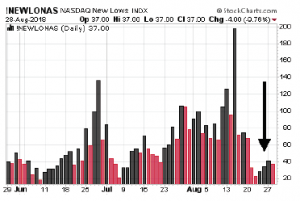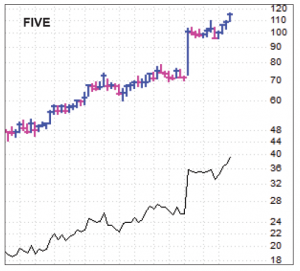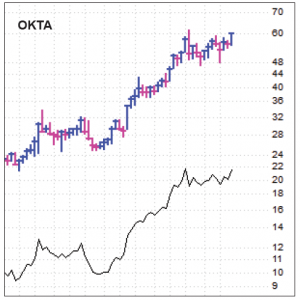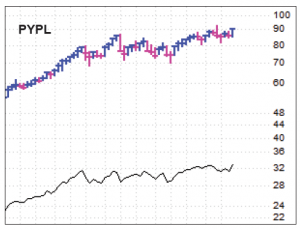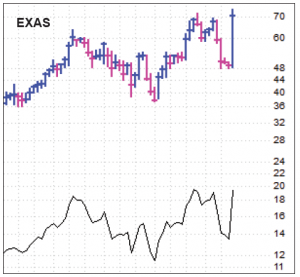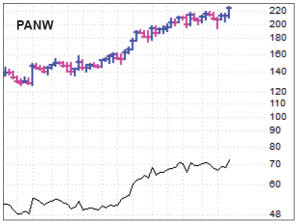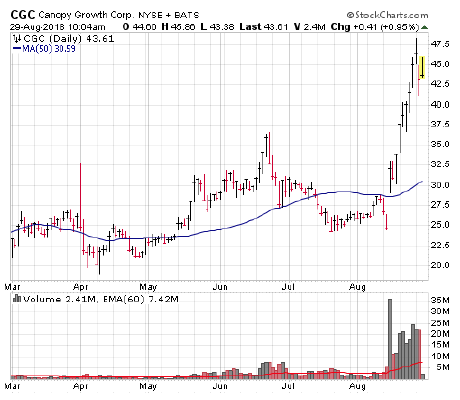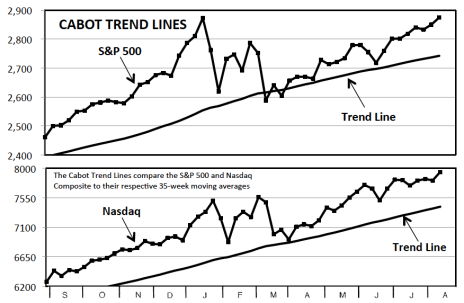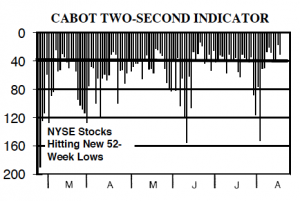The market overall and growth stocks in particular have shown great improvement during the past two to three weeks, with the major indexes hitting new highs and selling pressure drying up.
Granted, it’s late August, so we’ll see what big investors do when they come back from the beach next week, but given the evidence we’re continuing to put money to work. Tonight, we’re adding one new name, leaving us with around 17% in cash.
Cabot Growth Investor 1401
[premium_html_toc post_id="157583"]
Sellers Look Worn Out
From mid June through mid August, the market was choppy, narrow, news-driven and rotational—not a great environment for making money, and in fact, we got knocked out of a few stocks as they cracked support, often following earnings reports. And that two-month span, of course, came within a larger seven-month correction and consolidation for most stocks, sectors and indexes.
As we wrote on this page in our last issue, none of that action (either since mid June or since the market topped in January) shook our faith in the market’s longer-term outlook. Most signs tell us that the current bull market that began in October 2016 likely has further to run, and bigger picture, the secular bull move that started in 2013 (remember we made no net progress for 13 years before that) likely has years to go.
The question we had was really about the short- to intermediate-term. And there’s good news on that front, as the evidence has brightened considerably over the past couple of weeks.
We say that, first, because all of the major indexes have pushed to new highs—our Cabot Tides are clearly positive again after a few weeks on the fence. And growth stocks have led the way! The IBD 85-85 Index (a collection of stocks with both great relative strength and earnings growth) has moved to new highs in recent days, and our own Model Portfolio confirms the strength, up more than 13% year to date heading into this week.
But beyond just price action, we’re very encouraged by the market’s internals. Take the number of stocks hitting new lows, for instance—whether it’s on the NYSE (see our Two-Second Indicator on page 8) or the Nasdaq (shown here), we saw spikes in these figures in June, July and early August. But notice the extreme dry-up during the past seven trading days, an early hint that the sellers are out of ammo.
Obviously, it’s not all peaches and cream. We’re seeing a few signs of complacency (though, to this point, money flows remain tame, which is a plus), and volume has been light (late August, you know), so we’ll see what happens when big investors return to their desks after Labor Day.
Thus, we’re not advising a fully invested stance right now, but with the evidence improving, we continue to put money to work.
[highlight_box]WHAT TO DO NOW: Remain mostly bullish. In the Model Portfolio, we’re adding Autodesk (ADSK) in tonight’s issue, which will give us nine stocks and a cash position around 17%. Details inside.[/highlight_box]
Model Portfolio Update
Most big investors are likely still at the beach and will return after Labor Day, but we’ve been impressed with the action of the past few weeks, with growth stocks acting much better and the market shrugging off bad news (political uncertainty, no progress on the China trade front) and reacting positively to good news (earnings reports, possible Mexico trade deal).
Of course, it’s not 1999 out there, with large swaths of the broad market still in no man’s land. But with the evidence improving, we’re continuing to step back into a heavily invested position.
From our large cash position north of 50% after we got knocked out of Shake Shack (which, by the way, hasn’t been able to get off its knees), we’ve been putting cash to work, with three new purchases (including an add-on buy to Grubhub). Tonight, we’re taking another step into the water, adding Autodesk, which will leave us with around 17% in cash.
Current Recommendations
BUY—Autodesk (ADSK 156)—ADSK is the dominant provider of computer-aided design (CAD) software for the engineering, architectural and construction markets. If that doesn’t sound that exciting, it’s because it’s not; these aren’t massive growth markets, though the strong economy is certainly helping. The real attraction with Autodesk is its ongoing business transition—like Adobe before it, the company is moving away from one-time licenses and upgrades, and to a subscription-based approach that boosts the lifetime value of customers and provides better service (automatic upgrades, etc.), too. There have been some bumps in the road (we actually owned ADSK last year but got knocked out after a poor earnings report), but now big investors see the transition as more of a sure thing. In Q2, annualized recurring revenue (the key metric for the firm) lifted 28%, while “new model” recurring revenue boomed 115% as new subscriptions surged. Earnings also beat estimates, but more important is the big-picture outlook—with subscriptions gaining steam, Autodesk’s cash flow is surging, and should result in $1.3 billion of free cash flow next year with much higher numbers in the years after. As for the stock, it made no net progress from last November through mid August, but just leapt out of that consolidation on earnings. We think the stock is starting a sustained advance. We’re adding a 10% position to the Model Portfolio tonight.
BUY—Dexcom (DXCM 142)—DXCM is off to a good start for us, thanks in part to a flurry of analyst upgrades during the past couple of weeks. Part of the bullish vibes came from the firm’s acquisition of TypeZero (purchase price not disclosed), which has a proprietary platform that’s designed to make insulin dosing safer and easier for Type 1 diabetics using a continuous glucose monitor; it’s also developed an advanced data analytics tool. Both of those should help DexCom boost its capabilities and better compete with Medtronic and others. The stock remains extended to the upside, so if you don’t own any, consider starting with a smaller-than-normal position here or on dips of a few points. We like the post-earnings follow-through, the long-term breakout on earnings and, of course, the big potential of its G6 CGM, all of which bode well for higher prices down the road.
BUY—Five Below (FIVE 116)—FIVE has had a great couple of weeks, lifting from the upper 90s (where it successfully held its 10-week line) to the mid 110s, hitting new highs in the process. The next move could come down to the earnings report that’s due out next Thursday, September 6; analysts are looking for sales to rise 18% and earnings to lift 27%, though same-store sales trends and the updated outlook (including any trade war impact) will be just as important. Looking at the industry, it’s encouraging that Walmart reported some excellent numbers recently (fastest same-store sales growth in a decade), a sign that discount retailers are seeing solid demand. Still, we’re mostly focused on the firm’s longer-term growth outlook, so barring a complete disaster on earnings, we’re aiming to hold our remaining position, thinking the stock’s run has a long way to go. If you don’t own any, you can buy here or on dips of two or three points, but keep positions small this close to earnings.
BUY—Grubhub (GRUB 143)—GRUB has pushed above its post-earnings high from late July on good (not great) volume, joining the upmove among most growth stocks. There’s been nothing new from the company since its earnings release, and there’s been no change in our thinking, either—while competition exists, Grubhub is the clear leader in online food ordering and delivery, a market that has huge growth potential since just 2% to 3% of takeout orders are placed online. As with most stocks, GRUB could pull back a bit after its recent rally, but the trend is up. We’ll stay on Buy.
BUY—Ligand Pharmaceuticals (LGND 257)—LGND is in fine shape, trending higher above its 25-day line and tagging a new price high on Monday. Granted, the stock’s low trading volume (340,000 shares per day) has led to some big day-to-day swings, but the trend is up. Fundamentally, while drugs from Novartis and Amgen produce most of Ligand’s royalty revenue right now, it is collecting some small royalties from two other products (including a 20% cut of Evomela sales, which had $5.8 million of revenue in Q2 and is playing in a $100 million market). And another partner (Sage Therapeutics) could be getting approval near year-end for a postpartum depression treatment that one analyst thinks could eventually reach $600 million in sales. (LGND will get a 3% royalty on the drug.) And there are five more top-notch candidates all in Phase 2 or 3 trials! We’ll stay on Buy.
BUY—Neurocrine Biosciences (NBIX 122)—NBIX has nosed to new price highs this week, and while it could easily chop around for a bit, we think it’s near the start of a sustained run. In fact, NBIX’s relative performance (RP) line made no progress (it was just a market performer) from September 2015 through April of this year, but since then, the stock and RP line have rallied steadily, including the August 1 pop on earnings. We think big investors are starting to discount the company’s tremendous growth in sales (analysts see the top line rising from $162 million last year to $447 million this year and $655 million in 2019) and earnings ($-1.62, $0.16 and $1.79 per share) as the firm’s marketed and licensed products gain steam. We’re OK buying here, but if you want to aim for dips, a retreat toward the 25-day line (at 115 and rising) makes sense.
HOLD—Okta (OKTA 62)—OKTA has pushed to new closing price highs, which is certainly a plus. That said, we’re keeping the stock rated Hold because volume on the rally has been light and, more important, earnings are due out next Thursday (September 6), with analysts looking for sales to rise 39% and a loss of 19 cents per share. Will OKTA end up rallying like Five Below (which went nuts after a long pre-earnings consolidation) or sinking like Proofpoint (which broke down after its own report)? No one knows. In fact, “playing” earnings season is about portfolio management and executing a consistent plan. In our case, we tend to hold through reports, knowing we’ll get knocked around a few times, but because we’re investing in leaders in market uptrends, we should have more positive reactions than negative reactions, and holding allows us to develop bigger winners over time (which is where the real money comes from). Back to OKTA, we’re optimistic, but will see what comes. If you own some, hang on.
HOLD—PayPal (PYPL 93)—PYPL is another growth stock that’s rallied to new highs on light volume. The action is a plus, and reinforces our view that the stock’s longer-term uptrend is intact; if anything, the company’s position at the heart of the digital payments and money transfer movement has only strengthened in recent months with some of PayPal’s key acquisitions. The question, though, is whether the stock is starting its next leg up (a move that we think can go on for a bit given the stock’s rest in recent months), or whether the stock will pull back and chop around like it has after prior rallies. If you own some, hold on tightly to your shares, but we’d like to see a bit more constructive action (strength or tightness) before restoring our Buy rating.
BUY—Teladoc (TDOC 74)—TDOC is taking a breather after a big run-up this month. It’s interesting that, even though the U.S. population is increasing and aging, the number of hospitals is actually declining by about 0.5% or more per year. It’s not directly related to Teladoc (nobody’s using the Internet to have knee surgery), but it’s a sign that, especially in rural locales, seeing a specialist is getting more onerous, which should hike demand for virtual care solutions. Back to the stock, a pullback toward the 25-day (nearing 70) or even 50-day line (66.5 and rising) wouldn’t be a surprise after the recent run, especially if growth stocks as a whole take a rest. Longer-term, though, we see TDOC as relatively early in its overall run, with the initial breakout in May. We’re staying on Buy.
Watch List
Canopy Growth (CGC 46): CGC is hot as a pistol, so we’re not anxious to buy it here, but the volume coming into the stock has been impressive. See more on page 6.
Carvana (CVNA 63): CVNA is extremely strong; we’ll continue to monitor it for a shakeout or dip toward support. We think the fundamental story here is huge.
Docusign (DOCU 68): DOCU has a simple, powerful story (making it quicker and easier for agreements to get finalized), with solutions that can be used by just about any company in the world. The stock is perched near the top of its first consolidation; earnings are due out September 5.
Nutanix (NTNX 61): We were shaken out of NTNX a few weeks back, but the stock has rebounded with the market and we think the story remains big. If earnings, which are due out tomorrow (August 30), are well received, we could get back in.
Palo Alto Networks (PANW 231): We’re still believers in cybersecurity stocks, and PANW is the emerging blue chip of the group. See more on page 6.
Spotify (SPOT 191): SPOT isn’t showing much power since its post-earnings drop three weeks ago. Still, we’re optimistic growth will be robust for a long time, and are monitoring it for a lower-risk entry point.
Other Stocks of Interest
The stocks below may not be followed in Cabot Growth Investor on a regular basis. They’re intended to present you with ideas for additional investment beyond the Model Portfolio. For our current ratings on these stocks, see Updates on Other Stocks of Interest on the subscriber website or email mike@cabotwealth.com.
BJ’s Wholesale Club (BJ 29) — BJ’s Wholesale Club is a warehouse retail operator whose 215 clubs and 135 gas stations serve more than five million members in the Eastern U.S. The company sells all kinds of merchandise, including groceries at a significant discount (BJ’s says 25% or more). There’s a membership fee of between $55 and $110 per year, but it represents just 2% of annual revenue, and the company offers free trials several times a year. BJ came public just in late June, and offers investors slow, steady growth (3% last year and 4% in the two latest quarters of 2018 after an uncharacteristic 10% jump three quarters ago). A program of cost controls, data mining and a move into e-commerce has produced a string of impressive quarters for earnings growth (43% in the latest quarter after two quarters of triple-digit growth). It’s still a young stock, and isn’t going to set the world on fire, but we think big investors will likely build positions as they look ahead toward solid growth.
CarGurus (CARG 49) — While used-car superstore company Carmax (market cap of $13.5 billion and annual sales of $17.4 billion) is getting a ton of attention, CarGurus ($4.4 billion market cap and revenue of $383 million) is coming on strong. CarGurus (founded by Langley Steinert, the co-founder of TripAdvisor) was incorporated just in 2015 (versus 1993 for Carmax) and is growing its revenue much faster (up 60% in 2017 as opposed to Carmax’s 8% growth in fiscal 2018). The big differences are 1) CarGurus makes its money from car dealers’ subscriptions to its website and 2) the company operates globally, which is a much larger field for growth. CARG has a growing roster of institutional sponsors, but is still in its infancy, having come public just in October 2017. This is a great story, and the stock’s recent pullback looks intriguing.
Exact Sciences (EXAS 74) — Exact Sciences, the company behind the innovative Cologuard diagnostic screening test for colon cancer, is a great story, but also a bit of a wild child. Cologuard allows users to do the test at home, which increases compliance and the results are quite accurate. The addressable colon cancer test market is $14 billion and Exact Sciences owns just 2.6% of that, so the potential is huge. The number of health professionals ordering the Cologuard test is north of 110,000 and the company’s deal with Pfizer (kicking in half of a new $48 million in marketing money and a boost from Pfizer’s sales force) was very popular with investors. What we need to see from EXAS is a proper set-up, either a tightening up in the 70 region or a continuation of its August 22 rally that followed the Pfizer news and a buyable pullback. It’s worth watching.
Palo Alto Networks (PANW 231) — The Model Portfolio got knocked out of Proofpoint (PFPT) in early August after months of roller-coaster action, but the cybersecurity group still looks attractive. Emerging blue chip Palo Alto Networks also hacked around in June and July, but has broken out to new highs just this week, outperforming both PFPT and many peers. Palo Alto Networks will report its latest quarterly results on September 6, with analysts forecasting $633 million in revenue and $1.17 in earnings. With a stretch of range-bound trading stretching back to June, PANW has a solid base to build on. We’ll be watching the reaction to earnings closely.
Marijuana Stocks: The Next Big Thing?
Canopy Growth (CGC)
We’ve kept a very, very distant eye on the marijuana sector for the past year or so, mostly through our sister advisory, Cabot’s Ten Best Marijuana Stocks. But the vast majority of stocks in the group were either traded in Canada (which is set to legalize the drug nationwide this year), extremely low priced (more than half the stocks in the sector are priced below a buck) and/or were extremely thinly traded.
But the past couple of weeks might have marked a change in character. Yes, the stocks have run higher, but we’ve seen that before. What’s different this time is that (a) big, multinational players are buying into the sector and (b) some of the stocks are making moves on tremendous volume, a sign that institutional investors are getting involved.
Canopy Growth (CGC), traded on the NYSE, is probably the highest quality outfit in the group, with a ton of factors going for it. For example, the company has been granted the most supply agreements for Canadian provinces as that country legalizes marijuana, totaling 68 kilograms per year (representing 36% of supply agreements to date). Interestingly, Ontario, the largest province, has yet to ink its supply agreement, though Canopy is in the bidding.
Bigger picture, the company has five Canadian production facilities (5.94 million square feet) and operates in 11 countries through a few different subsidies. And it’s been building inventory to handle the demand coming later this year.
But the best part of the story is that Canopy has a major backer: Constellation Brands, the huge beverage firm (it owns Svedka, Corona, Modelo, Kim Crawford and more; $7.7 billion in annual revenue), recently boosted its stake in Canopy to 38% (paying $4 billion for it) and has the right to increase it north of 50% in the quarters ahead. Constellation will also have the right to nominate a majority of the board, so the tie-in here is very real.
Canopy is small but has been growing quickly (revenues up 61% each of the past two quarters) thanks to expanding output and prices, and the thinking is that as the company expands into a broader array of marijuana products (beverages, sleep and pain applications, etc.), Constellation will make sure Canopy gets the shelf/refrigerator space it needs at locations around the world. That said, it’s still very early—Canopy had revenues of just $88 million during the past year.
The stock’s valuation is in nosebleed territory ($8.5 billion!), but as we just saw, the smart people at Constellation are OK with that. And so are big investors, as CGC has gone bananas during the past two weeks on gargantuan volume. Would we buy it here? No, not after this run. But given the stock’s relative high quality and powerful blastoff, the next multi-week consolidation could provide an entry point. If you’re game, it’s worth keeping on your Watch List. WATCH.
Note: We have heard from a few people that don’t want to “support” the industry by getting involved in marijuana stocks, and we completely respect that. But we don’t view buying (or not buying) a stock in those terms (supporting a company or industry)—we’re just trying to use our methodology to make money in the market. CGC fits in that theme, so it’s a name we’re considering, at the right time and price.
You Can’t Kiss All the Babies
One common hiccup for investors is confusing trying to be right all the time (which is part of human nature) and making money (which is really the end goal of investing). One good example: wondering why we (or any advisor) hasn’t latched on to this, that or the other stock that’s had a big run.
The answer is simple: Just as a politician can’t kiss all the babies at a rally, an investor can’t own every stock that goes up in a bull market. There are too many of them! The good news is that you don’t have to own every stock that heads higher—you just need to own a couple of good names and handle them correctly to make a big move up in your portfolio.
Of course, there are times when the market has a couple of clear liquid leading stocks that growth investors should own. As I touched on in one of my presentations at this month’s Cabot Wealth Summit, I goofed by not owning Nvidia in 2016, and failing to get back in Netflix back in 2010 after it took off was a big mistake. Obviously, we’ve gone back and studied those costly decisions to avoid missing those types of names again.
But the fact is you’re never going to own every stock that’s rising in a bull market—and if you try, you’ll end up chasing your tail and hurting your performance. The goal is to make sure the stocks you do buy do well, not to try to own everything that heads higher.
Cabot Market Timing Indicators
The evidence of the market (our Cabot Tides are clearly positive again) and growth stocks (many have raced higher and the number of new highs has expanded) has shown improvement during the past three weeks. It’s not a perfect situation, but it’s encouraging and argues for putting more money to work.
Cabot Trend Lines: Bullish
During the past 18 years, the Nasdaq has advanced a total of 135%—but if you were long during buy signals from our Cabot Trend Lines and in cash during sell signals, you’d be up 250%! Thus, it’s a very dependable long-term indicator, and today the Trend Lines remain solidly bullish, as both the S&P 500 (by 4.8%) and Nasdaq (by 7.2%) are solidly above their respective 35-week moving averages, boding well for higher prices in the months ahead.
Cabot Tides: Bullish
Our Cabot Tides are also positive, so both the intermediate-term (Tides) and longer-term (Trend Lines) trends are pointed up. All five of the indexes we track are in plus territory, including the S&P 500—on the daily chart you can see it’s solidly above its rising, lower (50-day) moving average. At some point, of course, the sellers will take control, but right now, the bull market is firmly intact.
Two-Second Indicator: Neutral
The Two-Second Indicator revealed a spike in the number of new lows in the middle of August, but since then, we’ve been impressed by what we’ve seen, with seven of the past eight days showing fewer than 40 new lows. (The number of stocks hitting new lows on the Nasdaq has also dried up nicely; see page 1). Another few days of this would be a definite positive when it comes to the broad market.
[premium_html_footer]
Send questions or comments to mike@cabotwealth.com.
Cabot Growth Investor • 176 North Street, Post Office Box 2049, Salem, MA 01970 • www.cabotwealth.com
All Cabot Growth Investor’s buy and sell recommendations are made in issues or updates and posted on the Cabot subscribers’ website. Sell recommendations may also be sent to subscribers as special bulletins via email and the recorded telephone hotline. To calculate the performance of the portfolio, Cabot “buys” and “sells” at the midpoint of the high and low prices of the stock on the day following the recommendation. Cabot’s policy is to sell any stock that shows a loss of 20% in a bull market (15% in a bear market) from our original buy price, calculated using the current closing (not intra-day) price. Subscribers should apply loss limits based on their own personal purchase prices.
Charts show both the stock’s recent trading history and its relative performance (RP) line, which shows you how the stock is performing relative to the S&P 500, a broad-based index. In the ideal case, the stock and its RP line advance in unison. Both tools are key in determining whether to hold or sell.
THE NEXT CABOT GROWTH INVESTOR WILL BE PUBLISHED SEPTEMBER 12, 2018
We appreciate your feedback on this issue. Follow the link below to complete our subscriber satisfaction survey: Go to: www.surveymonkey.com/marketlettersurvey
Neither Cabot Wealth Network nor our employees are compensated by the companies we recommend. Sources of information are believed to be reliable, but are in no way guaranteed to be complete or without error. Recommendations, opinions or suggestions are given with the understanding that subscribers acting on the information assume all risks. © Cabot Wealth Network. Copying and/or electronic transmission of this report is a violation of U.S. copyright law. For the protection of our subscribers, if copyright laws are violated, the subscription will be terminated. To subscribe or for information on our privacy policy, call 978-745-5532, visit www.cabotwealth.com or write to support@cabotwealth.com.
[/premium_html_footer]

